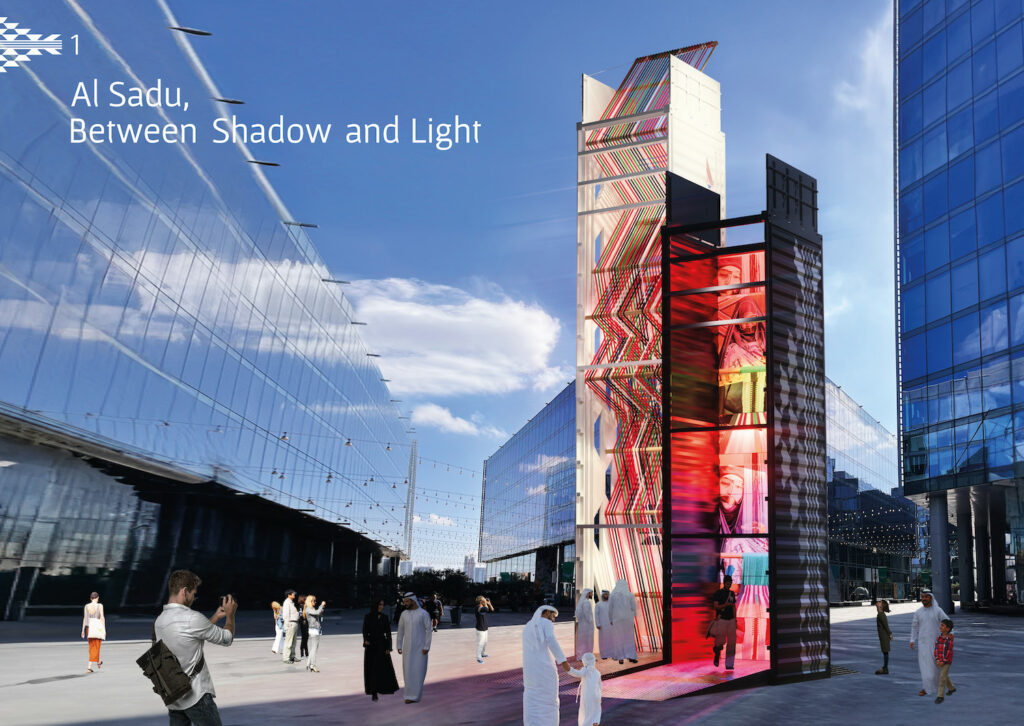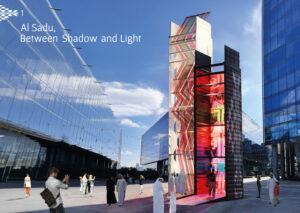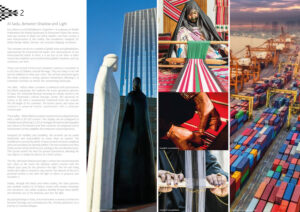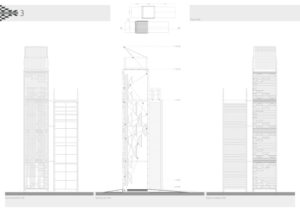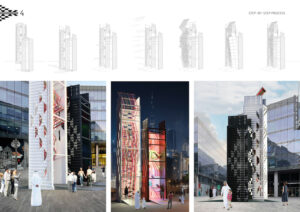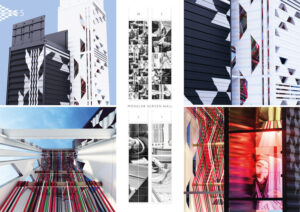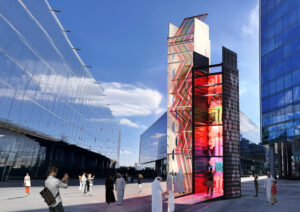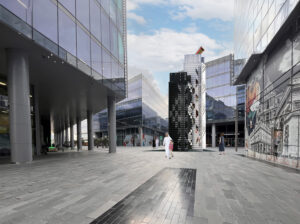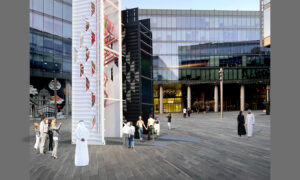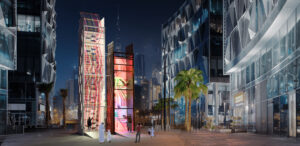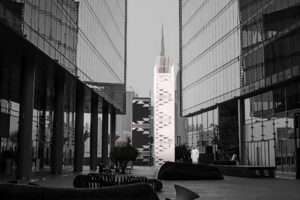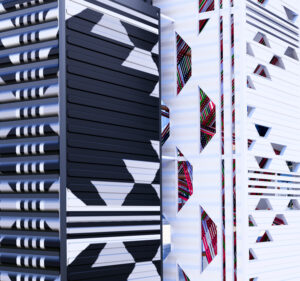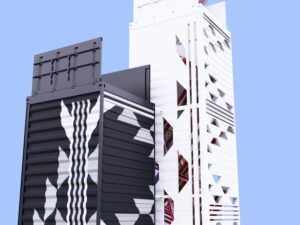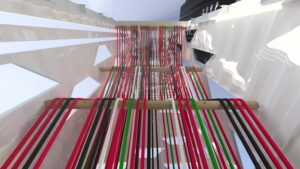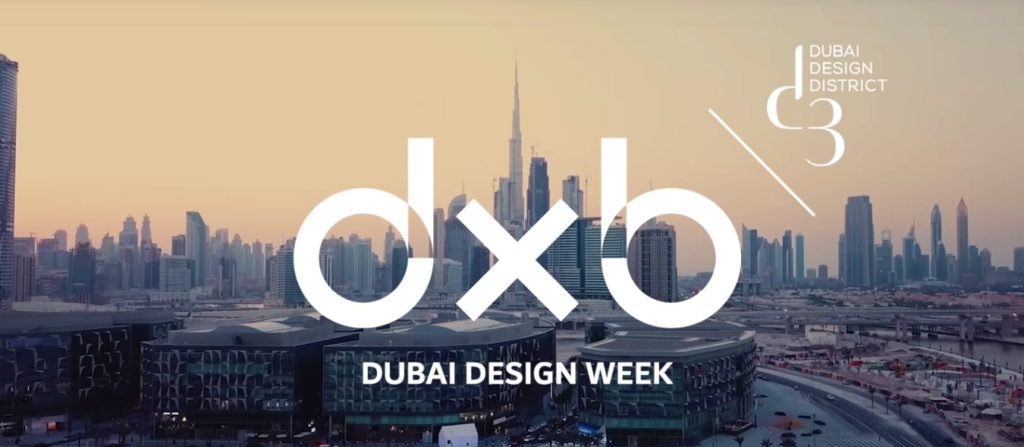
Dubai Design Week Competition
August 2025
Al Sadu: Between Shadow and Light
In a tribute to Lutfi Al Romhein’s “Together”—a sculpture on Sheikh Mohammed bin Rashid Boulevard in Downtown Dubai that unites man and woman in black and white marble—we have created a new interpretation of this duality. Our installation, designed for Dubai Design Week, features two recycled shipping containers.
The container serves as a symbol of global trade and globalization, representing the environmental impact and consequences of our interconnected world. In short, it is an icon of our time—a silent vessel that redefined and revolutionized global commerce and, by extension, our lives.
These two vertical Corten steel containers stand as a testament to a rich facet of Dubai’s cultural heritage. They are ready to set sail and be exhibited in other port cities. The vertical orientation gives the urban sculpture a strong, upward momentum, allowing it to command attention no matter the surrounding landscape.
The taller, 40-foot white container is enhanced with perforations and black engravings that replicate the iconic geometric patterns of Sadu, the traditional Bedouin weaving art deeply rooted in the Arabian Peninsula’s cultural heritage. Inside, this ancestral art comes to life with a monumental traditional loom that extends the full height of the container. The loom’s pieces and ropes are animated in perpetual motion, synchronized with a dedicated soundscape.
The smaller, 30-foot black container transforms into a digital window with a wall of 20 LED screens. This display can be configured in multiple ways (showing 20, 5, 2, or 1 image) to broadcast photographs and videos of the weavers and their creations. An integrated sound environment further amplifies this immersive visual experience.
Designed for mobility and durability, this artwork can be easily dismantled and reassembled as many times as needed. The installation is secured by a built-in base on each container, weighted with cast iron plates for optimal stability. The two containers are then firmly connected by metal tie rods, adding to the overall robustness. This system avoids the need for ground foundations, allowing the two objects to simply be placed on a level surface.
The title, “Between Shadow and Light,” echoes the natural materials and colors of the wool—the shadow—which contrast with the vibrant dyes used for the patterns—the light. This Yin-and-Yang duality also reflects a modern-day context: the shadow of this art’s potential decline is met with the light of efforts to preserve and revitalize it.
Finally, through this black-and-white duality, the Sadu patterns and symbols remind us of hidden stories with deeper meanings and narratives. Our urban sculpture humbly brings these beliefs and histories out of the shadows and into the light.
By paying homage to Sadu, our artwork aims to weave a connection between heritage and contemporary life, inviting audiences on a journey of cultural dialogue.
*** For this project, Claude Yacoub’s design is supported by two associate architects: Nivine Ibeche & Salah Hreeb.
The Realization of Al Sadu, Between Shadow and Light
Step 1: Procurement and Transformation
The project begins with the acquisition of two used shipping containers—one 40-foot and one 30-foot—from the port of Dubai or a specialized supplier.
The containers are then transported to a metal workshop for a complete transformation. Strategic cuts are made in their walls, and the raw edges are treated with rust-proofing and reinforced with frames. The artistic vision is realized by applying vibrant paint with Sadu-inspired patterns.
Step 2: Fabrication and Assembly
Simultaneously, a custom giant loom is designed and assembled by a metal artisan. Ropes made from recycled fabrics are mounted on the loom, ready to weave a monumental Sadu pattern. For a digital component, LED screens are installed on the interior wall of the black container, providing a platform for dynamic projections.
Step 3: On-Site Installation
Transporting the containers to the exhibition site is a precise logistical task handled by specialized trucks. Once on-site, two cranes are used to carefully position the containers vertically, holding them upright until the installation is complete. They are set on protective plates that safeguard the floor beneath them.
Step 4: Ensuring Stability
Stability is crucial for these vertical structures. To prevent tipping, custom-ordered steel road plates are used as ballast. Each plate measures 2.70m x 1.20m with a thickness of 30mm. Three to four layers of these plates are placed to cover the base of the container, providing a substantial weight of 6 to 8 tons per container.
To create a safe, anti-slip surface, these plates are covered with a checkered, striated stainless steel floor. The containers are further stabilized and integrated using sloped access ramps that serve as their “feet.” On the opposite side, steel profiles provide additional support. Finally, linking tubes are installed between the two containers to enhance their structural integrity and balance.
Step 5: Final Connections
The final step involves the electrical connections. This powers the entire setup, including the LED lighting, the projection screens with their playback system, and the complete sound system.
Project Timeline
This project can be completed in two months in Dubai, including both the workshop fabrication and the on-site installation. The goal is to have it ready for the November 4 opening of Dubai Design Week.
* Our design team will need to be supported by a local engineering firm to confirm our technical proposals.
** It’s important to note that this artwork is remarkably robust, with relatively simple and inexpensive upkeep and maintenance. This means it can be disassembled and reassembled at as many locations as needed. For example, it could be moved to different states within the United Arab Emirates or even elsewhere in the world.
